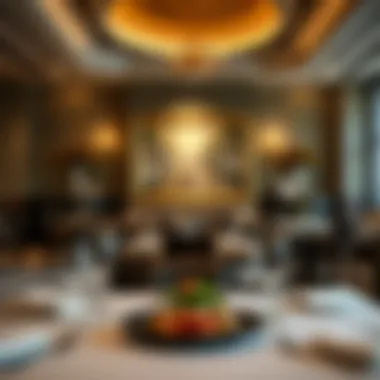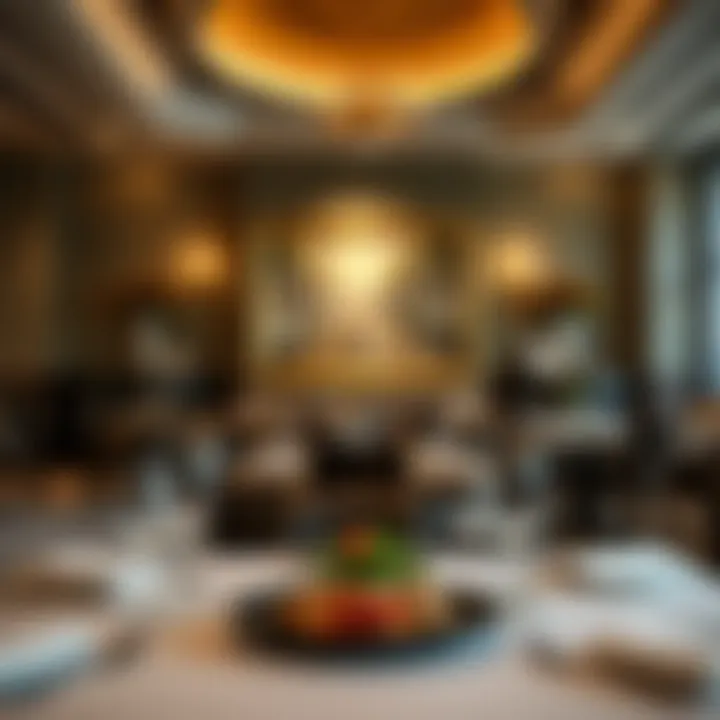Discovering the Essence of Fine Cuisine Restaurants


Intro
Fine cuisine restaurants have a way of weaving magic into meals that often transcends mere nourishment. It’s not just about what’s on the plate; rather, it’s an intricate ballet of flavors, textures, and aromas, enveloped in an ambiance that resonates with culture and artistry. Here, we embark on a riveting exploration of what sets these establishments apart—delving into not only the culinary artistry involved but also the deep cultural connections and ever-evolving trends that shape them.
Dining at a fine cuisine restaurant can be quite the experience. Each detail, from the carefully sourced ingredients to the impeccable service, plays a pivotal role in crafting a unique narrative for guests. This exploration aims to peel back the layers of sophistication that define fine dining, revealing insights that appeal to everyone from curious newcomers to seasoned gastronomes. Through thoughtful examination, we’ll draw connections between the world of fine cuisine and broader social dynamics, emphasizing how food intertwines with our shared stories and individual identities.
Defining Fine Cuisine
Understanding the essence of fine cuisine is crucial for anyone looking to appreciate the full spectrum of culinary artistry. It’s not just about the food on a plate; it encompasses a holistic experience that engages all the senses. Fine cuisine serves as an intersection where food, culture, and artistry meet. Those who enter into this world often find that it transcends mere sustenance and becomes a celebration of flavors, techniques, and presentation.
Characteristics of Fine Cuisine
When we dissect fine cuisine, several distinctive characteristics emerge. First and foremost, there’s the artistry involved in preparation. Chefs invest significant time honing their craft, mastering techniques that often take years to perfect. This is not about throwing ingredients together; it’s a meticulous process where precision reigns supreme.
Here are some hallmarks to consider:
- Ingredients Quality: The foundation of any fine dish begins with premium ingredients. Many establishments prioritize seasonal and local produce, allowing for optimal freshness and flavor.
- Technique: Techniques such as sous-vide, confit, or smoking might be employed to enhance the food's complexity and texture, often transforming the ordinary into the extraordinary.
- Plating and Presentation: This is where fine dining truly shows its flair. The arrangement of food is almost an art form, with every color and shape chosen for visual impact, making the dining experience as much about the eyes as it is about the palate.
- Ambiance: The physical space plays a vital role - elegant decor, soft lighting, and even the choice of music contribute to setting a refined atmosphere. All these elements come together to create a multi-sensory experience that goes beyond the meal itself.
"Fine cuisine is not merely about the food; it's a careful orchestration of taste, smell, sight, and experience that leaves a lasting impression."
Cultural Influences on Fine Dining
Fine dining is deeply entwined with the culture and history of its origin. Each dish tells a story, with roots tracing back centuries, reflecting local traditions and customs. Consider how French cuisine, known for its grandeur, has laid the foundations for what many consider the gold standard in fine dining worldwide. Other cultures contribute unique flavors, such as the spices from Indian cuisine or the techniques in Japanese cuisine, where simplicity often speaks volumes.
- Globalization's Impact: In our increasingly interconnected world, the fine dining scene sees a blend of influences; fusion cuisine is very much in vogue. Diners can now savor dishes that marry the meticulous nature of French cooking with the spices of Thai cuisine, resulting in something entirely fresh and exhilarating.
- Tradition vs. Innovation: Many chefs honor age-old recipes while simultaneously pushing boundaries. They craft dishes that encapsulate tradition yet resonate with contemporary palates, creating an evolving narrative in the world of gastronomy.
This merging of cultures not only enriches one’s palate; it fosters a deeper understanding and appreciation of global culinary art forms, leading to a more holistic dining experience. By understanding these cultural contexts, diners can engage more profoundly with the cuisine they enjoy, appreciating the layers of flavor and significance each dish holds.
Historical Context of Fine Cuisine
Understanding the historical context of fine cuisine is vital in grasping its present standing in the culinary world. The evolution over the centuries reveals not only shifts in taste but also the cultural exchanges that shape our dining experiences today. By exploring these origins, one can appreciate how fine dining has become synonymous with not just food, but art, tradition, and innovation. This background is essential for anyone keen on discerning the intricacies behind each dish served in a high-end restaurant, as one must know where it all began to fully appreciate the experience.
Origins of Fine Dining
The roots of fine dining can be traced back to ancient civilizations where food preparation and presentation were pivotal to societal gatherings. In Ancient Greece, grand feasts showcased a wide array of dishes prepared with specific methods, often influenced by seasonal availability and local herbs. As cultures traveled and traded, culinary styles blended, laying the groundwork for what would evolve into sophisticated dining.
The French revolution in the 18th century marked a significant shift in the fine dining scene. With the fall of aristocratic power, chefs who once worked for nobles began to open their own establishments. This democratization of fine cuisine allowed for a wider audience to experience the luxurious nature of well-prepared food, transforming dining from a privilege of the elite to a form of public enjoyment.
"Fine dining is not merely about the food but about the experience, the atmosphere, and simplicity made exquisite."
Evolution Through the Ages
Moving through time, the evolution of fine cuisine can be seen as a mirror reflecting societal changes. The Industrial Revolution brought about notable advancements in cooking technology, including gas stoves and refrigeration. These innovations allowed chefs to focus more on flavor and artistry than simply the mechanics of cooking.
In the 20th century, the rise of multiculturalism in many societies led to a rich tapestry of flavors and techniques merging within fine dining. Restaurants began celebrating not just local ingredient sourcing, but also the influence of immigrant chefs who introduced new cuisines to the dining landscape. For example, the embrace of Asian culinary techniques within Western fine dining establishments transformed palates and expectations, as now the global stage of cuisine is intermingled, offering flavors only previously imaginable.
In recent years, the concepts of sustainability and health consciousness have also come into play. Chefs seek to curate menus that not only tantalize the taste buds but also respect the environment. This awareness reflects a deeper understanding of the relationship between food practices and their impact on our planet. Dining has evolved past mere consumption; it has become a reflection of ethical choices and cultural respect.
This histroy sheds light on how fine dining today is a culmination of countless influences, revealing a narrative that is as much about heritage as it is about innovation. Every dish served on a fine dining plate might carry whispers of its history, making the act of dining a form of storytelling as well.
Culinary Techniques and Presentation
In the realm of fine cuisine, culinary techniques and presentation serve as cornerstones that elevate a meal from mere sustenance to an art form. They encapsulate a myriad of methodological approaches that chefs use to transform ingredients into exquisite dishes, ultimately creating memorable dining experiences. Understanding these techniques allows diners to appreciate not just the flavor but also the intention and skill behind each plate.
Precision in Cooking Methods
When one delves into cooking methods, precision becomes a critical factor. This encompasses the exact temperatures, times, and techniques used, ensuring that each ingredient maintains its integrity and enhances the final dish. For instance, sous-vide cooking uses precise temperature control to cook food evenly, resulting in a texture that is both tender and flavorful. Such methods showcase the chef's mastery, allowing them to present dishes that both look and taste incredible.
The importance of adopting meticulous cooking techniques extends beyond flavor and texture; it promotes food safety by ensuring that meats and seafood, for instance, are cooked to exact temperatures that minimize risk of foodborne illnesses.
"Cooking is one thing, but mastering techniques is akin to crafting a fine art. It's not just about following a recipe; it's about knowing the 'why' behind every step."


Moreover, methodologies like emulsifying, confiting, and poaching not only provide dimensionality to dishes but also reveal cultural nuances. For example, confit originated in ancient France and represents a way to preserve meats, showcasing a historical context that diners might not be aware of during their meal. The take-home message? When chefs apply these techniques with care, every bite can tell a story.
Artistic Plating and Presentation
Once the cooking methods have set the stage, plating and presentation come into play, captivating diners before they even take a bite. Think of a canvas — the plate is an artist's space, where colors, textures, and shapes blend harmoniously. A well-plated dish can transform simple ingredients into a feast for the eyes.
Chefs often employ various techniques when it comes to artistic plating, such as stacking, swirling sauces, and garnishing with microgreens or edible flowers. Each choice serves a purpose: to enhance visual appeal and; ultimately, to elevate the dining experience. For instance, a dish served on a rustic wooden plate might communicate farm-to-table freshness, while a sleek white dish often emphasizes cleanliness and sophistication.
Furthermore, the arrangement dictates how diners engage with the dish. The placement of elements on a plate can guide the eye and spark curiosity. A thoughtfully arranged meal encourages diners to explore flavors in a certain sequence, igniting the senses and enhancing their overall experience.
In addition, with the rise of social media, visual presentation has taken on a new significance. Diners are often eager to share their experiences, so a stunning presentation can enhance a restaurant's visibility, making it a critical component of modern dining.
Related Resources
By paying careful consideration to both cooking methods and presentation, diners not only enjoy delicious meals but are also part of a larger narrative infused with culture and history.
Ingredient Sourcing
The backbone of any fine cuisine restaurant lies in its ingredient sourcing. It goes beyond simply procuring food items; it's about establishing a connection to the essence of culinary expression. The quality and origin of ingredients play a pivotal role in determining the flavors and overall dining experience. For high-end establishments, this can mean the difference between an unforgettable meal and a rather forgettable one. In this section, we’ll dissect the importance of ingredient sourcing, emphasizing quality and sustainability.
Importance of Quality Ingredients
Choosing quality ingredients cannot be overstated. Fine dining thrives on impeccable taste, texture, and presentation—all rooted in the selection of superior ingredients. This might often translate to sourcing produce that is harvested at its peak ripeness or meats that come from farms known for their ethical practices. The impact of these choices can be seen in several ways:
- Flavor Amplification: Fresh, high-quality ingredients amplify the dish’s flavor profile. For example, heirloom tomatoes cultivated organically will taste far superior to their commercially grown counterparts.
- Health Consciousness: Quality ingredients often imply fewer additives and preservatives, appealing to health-conscious diners. Patrons increasingly prioritize wholesome dishes that make them feel good, both physically and emotionally.
- Culinary Innovation: When chefs can access unique, high-quality ingredients, they often push boundaries, leading to inventive dishes. Imagine a dish made with a rare spice sourced from a remote village; it invites a new narrative and not just a meal.
Sustainable and Local Sourcing
The trend towards local and sustainable sourcing has gained significant traction in recent years. Consumers are not only concerned with how food tastes, but also where it comes from and how it is produced. Here’s why local sourcing deserves the spotlight:
- Connection to Community: Sourcing local ingredients fosters a bond between restaurants and their community. Diners feel a sense of pride knowing that they are supporting local farmers and businesses, and this can enhance their dining experience. It’s like bringing a slice of local culture onto their plate.
- Reduced Carbon Footprint: Locally sourced foods often require less transportation, which reduces greenhouse gas emissions. This appeal to eco-conscious consumers can elevate a restaurant’s reputation as sustainability becomes a dining norm.
- Seasonality and Freshness: Eating with the seasons means that the dishes offered are consistently fresh. An establishment that features seasonal menus can intrigue diners, inviting them to return for new offerings.
"The ingredients we use tell a story—of where they come from, who grew them, and how they can transform a meal into an unforgettable experience."
In the face of rising global consumption patterns, how a restaurant approaches ingredient sourcing will likely shape its legacy. Observing trends in sourcing strategies not only enhances culinary quality but can also foster a resilient dining culture that stands the test of time.
Link to further reading: Wikipedia on Culinary Arts
Link to sustainability practices: National Sustainable Agriculture Coalition
Link to local farming initiatives: LocalHarvest
The Fine Dining Experience
The fine dining experience is the crown jewel in the world of culinary arts. It amalgamates all the elements of superior dining into one memorable affair. Every detail, from the ambience to customer service, plays a critical role in crafting an exceptional meal that transcends mere sustenance. An experience at a fine cuisine restaurant is not just about food; it’s an immersion into a carefully curated atmosphere that captivates all the senses.
Dining at a fine restaurant should feel like stepping into a different world. Upon entering, patrons are greeted not just with a meal, but with art, design, and historical narratives that can be found in each dish served. This high-caliber experience brings joy, comfort, and elegance to the table, making it worthwhile to celebrate important occasions or simply indulge in life's pleasures.
Ambiance and Atmosphere
When it comes to fine dining, ambiance is king. A well-crafted environment can transport diners to a different time and place, evoking emotions that elevate the entire meal. Think about the soft glow of candlelight casting shadows on a beautifully set table, with delicate music floating in the background. These factors aren’t extras; they’re part and parcel of what makes dining worthwhile.
The decor often tells a story, reflecting the culinary traditions it represents. Whether it's a classic French bistro adorned with vintage posters or a contemporary fusion restaurant with sleek lines and bold artwork, the atmosphere plays a huge role in setting expectations for the meal.
Additionally, the layout fosters varied experiences; some diners may prefer intimate nooks for private celebrations, while others enjoy the buzz of a bustling open space. Ultimately, the mood greatly affects the overall enjoyment—creating lasting memories that extend far beyond the plate.
Exceptional Customer Service
Exceptional service is the backbone of fine dining, and it goes well beyond just delivering the food. Well-trained staff can anticipate needs, making recommendations and acknowledging preferences that make each guest feel special. It’s that little touch, like knowing a repeat visitor favors a particular wine or remembering that a diner is vegetarian, that marks the difference between good service and truly exceptional service.
In a fine dining restaurant, the staff’s knowledge is expected to match the quality of the cuisine. Attentiveness without being intrusive is essential. The service should feel seamless, as if every motion is choreographed. Guests desire to be treated with respect and attentiveness, not just as customers, but as honored guests.
"High-quality service is about more than just taking orders; it’s about creating a connection that enhances the dining experience."


Moreover, how issues are handled when they arise can define a dining experience. Whether it’s adjusting an order or addressing a concern, the response should be prompt and gracious, leaving no room for irritation. This dedication to service cultivates loyalty, encouraging diners to return time and again.
Trends in Fine Dining
In the ever-evolving landscape of gastronomy, trends in fine dining play a crucial role in defining what it means to experience luxury in a restaurant setting. These trends shape not only the menus that are presented but also the atmosphere, the service style, and the overall experience offered to diners. Understanding current trends, therefore, is invaluable for both restaurant owners and patrons alike. It creates a gateway to not just enjoying good food but appreciating the cultural exchange and innovation that fine dining embodies.
As discerning diners seek memorable experiences, restaurants must adapt quickly to remain competitive. This ongoing adaptation can be seen in the introduction of thematic dining, a style where restaurants take patrons on a culinary journey that often narrates a story through its dishes. Here, it is not merely about what is served, but about how the entire experience interweaves narrative, aesthetics, and sound—a multi-sensory engagement.
Innovations in Gastronomy
When discussing trends, it's impossible to overlook the significance of innovations in gastronomy. This encompasses a range of exciting approaches that chefs are employing to enhance the dining experience. Techniques such as molecular gastronomy exemplify this trend by allowing chefs to manipulate food at the molecular level, often resulting in surprising textures and flavors that challenge traditional perceptions of cuisine.
Here are some key innovations currently making waves in the culinary world:
- Textural Play: Chefs are increasingly using textural contrasts in their dishes, creating a balance of crispy, creamy, and smooth elements even within a single plate.
- Fermentation: This age-old technique has re-emerged as chefs explore the complex flavors that fermented foods can bring to the table. Expect to see kimchi or miso not just as side dishes but as integral components of a main course.
- 1.7 Degree Precision: With the advent of sous-vide cooking, temperature control has reached an unprecedented level. This precision ensures that proteins are cooked perfectly every time.
The implementation of these innovations not only pleases the palate but also enhances the overall aesthetic and narrative of the dining experience.
In embracing these diverse culinary techniques, chefs continue to push boundaries, making meals a canvas for artistic expression.
The Rise of Plant-Based Fine Dining
Another prominent trend in fine dining is the rise of plant-based fine dining. As awareness of health and environmental issues rises, many diners are making conscious choices about the food they consume. This shift is mirrored in fine dining establishments that have started to highlight plant-based options, offering dishes that are as refined and elaborate as their meat-heavy counterparts.
- Creative Ingredient Pairing: Chefs are leveraging seasonal vegetables, grains, and legumes, transforming them into unexpected flavor profiles. This requires a strong understanding of food pairing and creativity that rivals traditional protein-based dishes.
- Focus on Sustainability: A plant-based approach often signals a broader commitment to sustainability. Diners are more aware than ever of where their food comes from, prompting a movement toward locally sourced ingredients. Chefs often take pride in partnering with local farmers to ensure the freshest produce, thus re-establishing community ties.
- Wine Pairings: There’s also an evolving landscape when it comes to beverage pairings. Wine lists are adapting to complement plant-based dishes, featuring organic and biodynamic varieties that reflect the ethos of sustainability.
"The commitment to incorporating diverse plant-based elements not only caters to a growing demographic but also enriches the culinary tapestry, making fine dining an even more inclusive space."
Challenges Faced by Fine Cuisine Restaurants
Running a fine dining establishment is akin to walking a tightrope. One misstep, and you could find yourself tumbling into a cascade of challenges that could jeopardize not only the restaurant’s reputation but also its very existence. This segment delves into two of the most critical hurdles faced by fine cuisine restaurants today: economic viability and sustainability, alongside the relentless pursuit of maintaining high standards amid fierce competition.
Economic Viability and Sustainability
Economic viability is foundational. It’s the bedrock that allows fine cuisine restaurants to flourish within a dynamic and often tumultuous dining landscape. The costs associated with high-quality ingredients, skilled labor, and exceptional service can pile up, creating a financial strain. For instance, sourcing local and organic produce might be noble, yet it frequently comes at a price that can pinch the profit margins significantly.
- High Operational Costs: Rent in prime locations, labor wages, and utilities can be daunting. High-end venues often find themselves trapped in a cycle where every aspect from table settings to the culinary techniques used must reflect luxury, driving up costs.
- Seasonal Variability: The dependency on seasonal ingredients influences what can be served. Adjustments may be required to remain profitable, often leading to a menu that shifts frequently.
Moreover, sustainability has risen to prominence. In an age where eco-consciousness is pervasive, fine dining cannot afford to be oblivious. Restaurants that prioritize sustainability not only meet customer demands but also contribute positively to the planet. Adopting practices such as waste reduction, composting, or sourcing from responsible suppliers can yield two-fold benefits: attracting a conscientious clientele and reducing overhead costs.
"When dining experiences align with environmental responsibility, it draws patrons who seek more than just a meal; they crave a cause."
Maintaining High Standards Amid Competition
Competition in the fine dining sector has never been stronger, with new establishments springing up like daisies in spring. This explosion of options puts enormous pressure on existing restaurants to keep their standards high. It’s not just about serving good food anymore; it’s about creating an unforgettable experience.
- Innovation Required: Restaurants have to continually innovate—not just their menus, but their overall dining experience, including service, ambiance, and storytelling. Patrons are often looking for a narrative behind their dishes that resonates with them personally.
- Word-of-Mouth and Online Reviews: With social media and review platforms, a single dining experience can be amplified. A negative review can spread like wildfire, damaging a restaurant’s reputation before the chefs can even plate their next dish.
Furthermore, the output of various Michelin-starred chefs and culinary influencers raises the stakes, pushing restaurateurs to invest in training and development for their staff. The relentless pursuit to elevate every aspect of dining fosters an environment where anything less than perfection is deemed subpar.
Learn more about the fine dining industry and its challenges at Britannica.
Culinary Awards and Recognition
Culinary awards serve as a shining beacon in the world of fine dining, offering recognition and validation for the craft of chefs and their establishments. For many, these accolades aren't just about prestige; they are also a reflection of hard work, dedication, and an unyielding pursuit of quality. Being honored with such awards can bring substantial benefits, both for the restaurant and its culinary team. They enhance a restaurant's reputation, attract more patrons, and can even lead to increased revenue. Also, these awards influence the standards within the industry, pushing chefs to innovate and elevate their skills. Furthermore, they often introduce diners into the intricacies of fine cuisine, fostering a deeper appreciation for the art of cooking.
In the landscape of fine dining, two awards stand out above the rest: the Michelin Stars and the James Beard Awards. Each award possesses its unique weight and significance, giving diners and food lovers a reliable compass in navigating the diverse and sometimes overwhelming restaurant scene.
Michelin Stars: An Overview
The Michelin Star system, pioneered by tire manufacturer Michelin, began as a guide for travelers looking for decent dining options while on the road. Today, it is a renowned benchmark of excellence in culinary artistry. A single star denotes a "very good restaurant in its category," while two stars indicate a restaurant worthy of a detour. Three stars, the highest accolade, are reserved for those establishments offering an unforgettable dining experience, showcasing exceptional cooking.


Critics often argue about the rigid criteria used to judge these restaurants. Factors such as the quality of ingredients, mastery of technique, personality of the cuisine, and consistency all play a part. Chefs and restaurateurs aspire to this distinction, understanding the profound impact it can have on their establishment's future.
Some of the most acclaimed chefs in the industry, like Alain Ducasse and Massimo Bottura, have made their careers in pursuit of these stars. For instance, Ducasse operates multiple Michelin-starred venues across the globe. Thus, achieving a Michelin Star could be likened to winning an Olympic medal—an indication of mastery and hard work.
"A Michelin Star means the world to a chef; it's validation, but also a constant reminder of the effort needed to maintain such excellence."
James Beard Awards and Their Significance
The James Beard Awards, established by the James Beard Foundation in memory of the influential American chef, celebrate chefs, restaurants, and culinary educators across the United States. Unlike the Michelin Stars, which are mostly awarded in Europe and certain cities in Asia, the James Beard Awards encompass a broader spectrum of culinary excellence.
These awards acknowledge not only the meticulously crafted dishes of fine dining establishments but also the impact of those who contribute to local food systems, sustainability, and cultural diversity in cuisine. Categories range from Best Chef: New York City to Outstanding Restaurant, ensuring recognition is vast and inclusive.
Winning a James Beard Award can significantly elevate a chef's profile, but it also bestows a sense of responsibility. Chefs and restaurateurs who are awarded often feel compelled to uphold the highest standards, inspire others, and remain involved in their communities.
In essence, culinary awards, whether Michelin or James Beard, shape the fine dining landscape profoundly. They not only elevate dining experiences but also encourage innovation and cultural appreciation in the culinary arts.
The Role of Technology in Fine Dining
In today's fast-paced world, technology has snuck its way into every nook and cranny of our lives, and the realm of fine dining is no exception. It's not just about fancy plates and exquisite flavors anymore; the intersection of gastronomy and technology has opened new avenues for enhancing diners' experiences. From optimizing client reservations to refining culinary techniques, technology plays a pivotal role that can't be overlooked.
Adapting to technology has become a necessity rather than a choice for fine dining establishments. The digital age has revolutionized how restaurants operate, bringing opportunities that enhance customer engagement and streamline processes while maintaining top-notch quality. At its core, technology is all about increasing efficiency, improving accessibility, and ultimately providing a more memorable dining experience.
Digital Reservations and Customer Engagement
One of the most significant shifts in fine dining is the adoption of digital reservation systems. Gone are the days when a simple phone call was enough to secure a table. Nowadays, platforms like OpenTable, Resy, and Tock offer a seamless booking experience that’s just a few clicks away. This isn't just convenient for diners; it helps restaurants manage their seating and reduce no-shows.
With these platforms, diners can peruse menus, read reviews, and even select specific tables. This level of transparency fosters a sense of connection and trust. When customers feel more involved in the reservation process, they are more likely to show up and have a positive experience.
Moreover, restaurants use customer data gleaned from these platforms to tailor services and offers. For instance, if a diner frequents a certain restaurant, that establishment might send special promotions or create personalized dining experiences based on past orders. This tailored engagement keeps regulars coming back for more and attracts new patrons who appreciate the personal touch.
Innovative Cooking Tools and Techniques
The kitchen has not been left behind in this technological revolution. Innovative cooking tools and techniques are enhancing fine dining chefs' abilities to experiment and perfect their craft. Sous-vide machines, for instance, allow chefs to cook food to precise temperatures, ensuring perfect doneness every time. This method not only enhances flavor but maintains the integrity of the ingredients.
Furthermore, 3D food printing is making headway into gourmet kitchens, enabling chefs to create intricate designs that were once impossible to achieve. Imagine a mouthwatering dessert sculpted down to the last detail, perfectly delicate and utterly eye-catching. Such advancements push the boundaries of culinary artistry, engaging diners not just through taste but also through visual artistry.
Additionally, the rise of smart ovens and automated cooking systems helps maintain consistency in food preparation. Chefs are more focused on creativity while technology handles redundancies, which can free them to innovate further.
Technology doesn’t replace the human element; it amplifies it. With these tools, chefs harness the best cooking techniques while adding their personal flair, creating dishes that provoke thought and elicit emotion.
"In fine dining, technology is not just a tool; it's an enabler for creativity and personalization that elevates the dining experience."
In sum, technology's role in fine dining is a multifaceted one, touching every aspect from reservations to the kitchen. As the industry continues to embrace these changes, it creates an evolving landscape where diners can expect greater engagement and chefs can afford to push their limits.
For more insights on this topic, you might visit resources on Wikipedia or Britannica.
Culinary Education and Profession
Culinary education plays a crucial role in shaping the fine dining landscape. It's not just about knowing how to chop vegetables or sauté meat; it’s about mastering an art form where flavors and techniques intertwine seamlessly. For those who aspire to create that unforgettable dining experience, a solid foundation in culinary principles is paramount. This education lays the groundwork for creativity and innovation in cuisine.
Training for Aspiring Chefs
The journey of becoming a chef often starts with formal training. Culinary schools, such as Le Cordon Bleu and the Culinary Institute of America, provide in-depth programs that cover everything from basic knife skills to advanced cooking methods. These institutions emphasize the importance of hands-on training under the supervision of seasoned professionals. Aspiring chefs get a taste of various cuisines and techniques, helping them find their own style.
Moreover, internships at fine dining establishments are invaluable. They expose students to the fast-paced kitchen environment and the demands of high-quality service. Working alongside skilled chefs enables them to learn not only how to prepare exquisite dishes but also the importance of timing and teamwork in delivering a successful service.
"The kitchen is a place of constant learning, where every dish teaches you something new."
Furthermore, the mentorship aspect of culinary training cannot be overstated. New chefs absorb knowledge from veterans, learning the subtleties that can elevate a dish from good to exceptional. This interaction often sparks creativity and pushes them to experiment with flavors, leading to the development of signature dishes that can transform a restaurant’s menu.
The Importance of Continuous Learning
In the dynamic world of fine dining, the learning never really stops. Culinary arts are always evolving, much like fashion or technology. Trends shift, styles change, and techniques get refined. Continuous education allows chefs to stay ahead of the curve, ensuring their culinary offerings remain fresh and relevant. Workshops, online courses, and culinary competitions offer opportunities for further development.
Keeping abreast of international cuisine trends and dietary shifts such as veganism or gluten-free diets is also crucial. Fine dining is increasingly accommodating diverse dietary needs, and understanding these trends can expand a chef's repertoire significantly.
There's also the advent of technology; chefs now utilize high-tech equipment and innovative cooking techniques, like sous-vide or molecular gastronomy. Staying updated on these advancements enables culinary professionals to enhance their cooking processes and introduce exciting new dishes.







